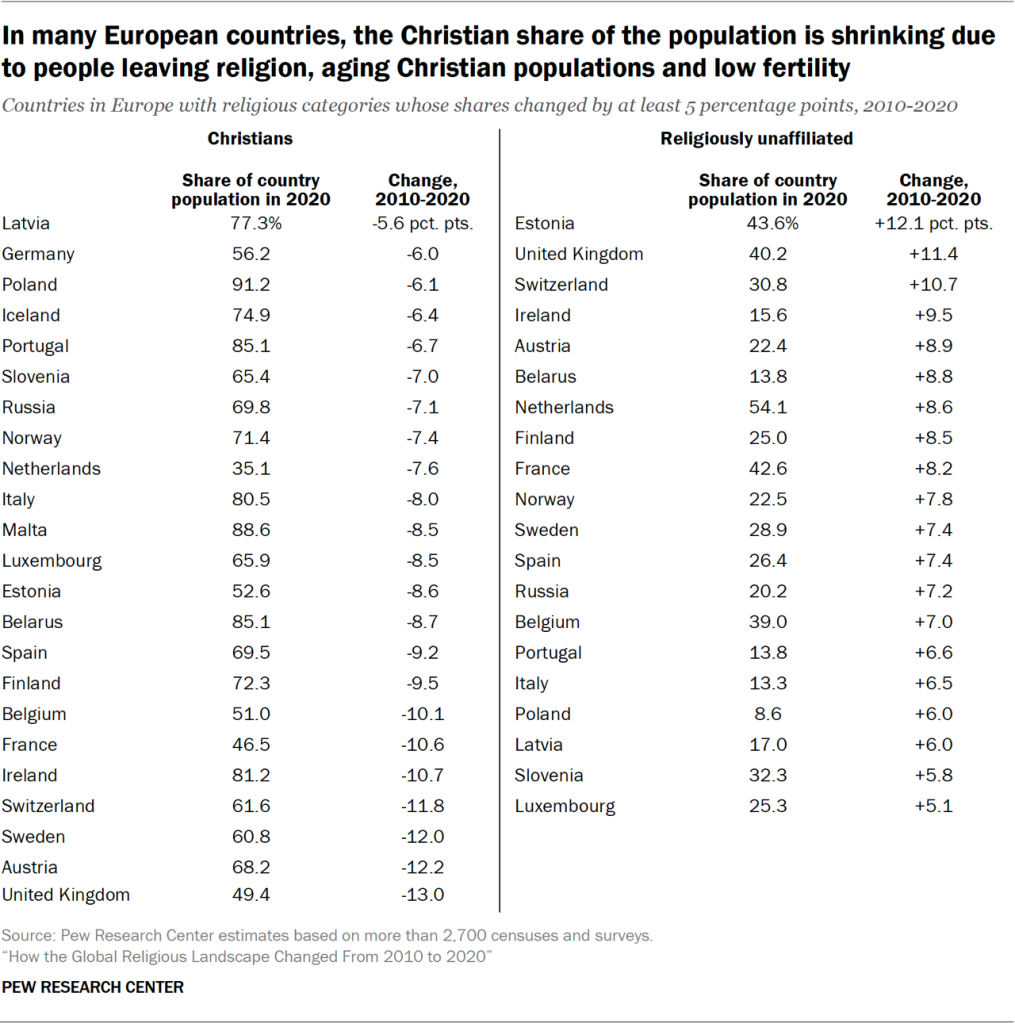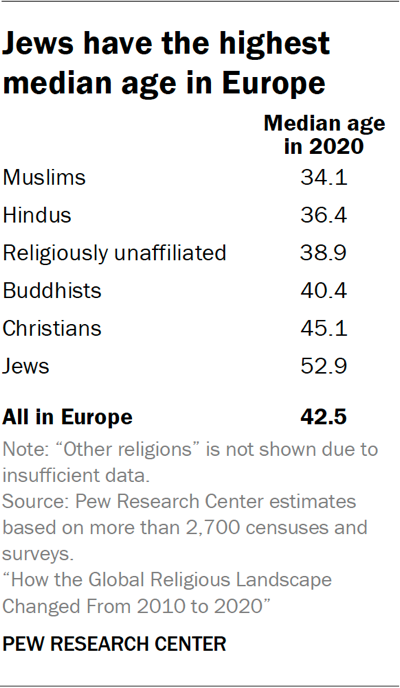As of 2020, Europe has about 753 million inhabitants, only 2% more than in 2010. Roughly two-thirds of Europeans in 2020 are Christians, and a quarter are religiously unaffiliated. Around 6% of Europe’s residents are Muslims.
In many European countries, there has been a decades-long pattern of religious “switching,” with people who were raised as Christians becoming religiously unaffiliated. This widespread disaffiliation has contributed to the thinning of Europe’s Christian population and the swelling of the ranks of the religiously unaffiliated.
Between 2010 and 2020, France and the United Kingdom lost their Christian majorities, and the Netherlands gained an unaffiliated majority.

Religious change
Between 2010 and 2020, the absolute number (or count) of Christians dropped by 9% to 505 million. Jews also decreased in count, by 8%, to 1.3 million in 2020. Meanwhile, every other major religious group grew in number in Europe. The religiously unaffiliated expanded the most, numbering 190 million in 2020 (up 37%). Muslims increased to 46 million (up 16%). Europe’s relatively small Hindu population also grew substantially, rising to 2 million (up 30%).
There were also changes in the percentages (or shares) these groups made up of Europe’s overall population. The biggest driver of change between 2010 and 2020 was religious disaffiliation: The share that Christians made up of the region’s population dropped to 67% (down 8 percentage points), while the share of religiously unaffiliated people rose to 25% (up 7 points). Every other group saw less than a 1-point change over the decade.
Immigration to Europe from Muslim-majority countries elsewhere in the world generated a lot of public discussion between 2010 and 2020, particularly as many refugees arrived from Syria.
Overall, the share of Europe’s population that is Muslim grew by less than 1 percentage point, to 6% in 2020, but the change was not evenly distributed. In Sweden, where government policies toward Syrian refugees were generous, Muslims grew to make up 8% of the country’s inhabitants (up 4 percentage points, or roughly double the share of Sweden’s population that Muslims had been in 2010).
Muslims also increased as a share of the overall population by about 4 points in Albania, where they already made up a majority in 2010. The Muslim share was more stable in other European countries. For example, in Germany, where then-Chancellor Angela Merkel’s welcoming stance toward Muslim refugees in 2015 was highly controversial, Muslims grew by about 1 percentage point as a share of the country’s population, making up 7% of the country’s residents in 2020.
Substantial change within countries
Among regions, Europe has the largest number of countries (23) that experienced a substantial change (of 5 percentage points or more) in at least one religious group’s share of the population. Every such change in the region reflected declining percentages of Christians. In most of these countries (20), religiously unaffiliated people increased as a share of the population by at least 5 points.
The largest shift, in terms of percentage point change, occurred among Christians in the United Kingdom, where Christians shrank to just under half of the UK’s population (down 13 points). At the same time, religiously unaffiliated people increased to 40% of the UK population (up 11 points). A slightly larger change among the religiously unaffiliated occurred in Estonia, where they grew to represent 44% of the country’s population (up 12 points).
In Europe, two countries – France and the UK – had Christian majorities in 2010 and no longer do. Meanwhile, the Netherlands became the second unaffiliated-majority country in Europe, joining the Czech Republic.
Aside from Christians and unaffiliated people, no religious group saw its share in any European country change by 5 percentage points or more between 2010 and 2020.

Median age of religious groups
Europeans are older, on average, than people in any other region, with a median age of 42. Europe has slower population growth than other regions largely because of relatively low fertility rates and large percentages of older adults. In fact, the populations of some European countries would have shrunk since 2000 if not for immigration, because deaths have outpaced births.

Muslims are the youngest religious group in Europe, with a median age of 34. The median age of European Jews – the oldest group in the region – is approximately 53.
Hindus (36 years), religiously unaffiliated people (39) and Buddhists (40) all have median ages below the region’s overall figure. We do not have sufficient data on adherents of other religions in Europe to reliably estimate their age structure.
As with Jews, Christians (45) tend to be older than other Europeans.




